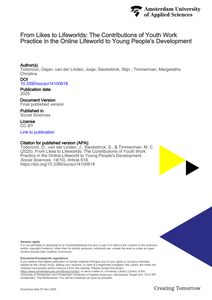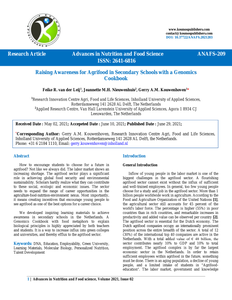Twenty sixteen year old fourth-graders of the School for Young Talent (School voor Jong Talent) in The Royal Academy of Fine Arts, Design, Music and Dance (Hogeschool van Beeldende Kunsten, Muziek en Dans) participated in a pilot project that combined music, dance and visual arts in a creative process. A group of six teachers from three different disciplines guided the young artists. This report shows how this process took place and indicates some of the issues that were encountered along the way.
DOCUMENT

Theatervoorstelling ‘Angry Young Men’ is een hip-hop voorstelling van theaterorganisatie WAT WE DOEN. De voorstelling vertelt het verhaal van twee jongens die opgroeien in een wereld waarin ze hun plek niet kunnen vinden. Die op straat hangen. Ze dromen van geld en aanzien, als het moet via de criminaliteit. Aan de hand van gesprekken (een combinatie van rap en spel) met hun moeders en verschillende professionals (docenten, jongerenwerkers, therapeuten, wetenschappers en politieagenten) kijkt het publiek terug op de levens van de jongens: de ene jongen komt om het leven bij een schietpartij. De andere jongen zit vast voor diezelfde schietpartij. Dader en slachtoffer. Ze proberen uit vinden of hun levens anders hadden kunnen lopen. En wie had het dan anders moeten doen?
DOCUMENT

This book examines the much-debated question of how to unleash the potential of young people with promising intellectual abilities and motivation. It looks at the increasingly important topic of excellence in education, and the shift in focus towards the provision of programs to support talented students in higher education. It provides a systematic overview of programs for talented students at northern European higher education institutions (HEIs). Starting in the Netherlands, where nearly all HEIs have developed honors programs over the past two decades, the book explores three clusters of countries: the Benelux, the Nordic and the German-speaking countries. For each of these countries, it discusses the local culture towards excellence, the structure of the education system, and the presence of honors programs. In total, the book reviews the special talent provisions for nearly four million students at 303 higher education institutions in eleven countries. In addition, it offers an analysis of the reasons to develop such programs, a look into the future of honors education and a practical list of suggestions for further research.The Sirius Program assigned Marca Wolfensberger to carry out this research.
LINK
The present study examined differences in visual search and locomotor behavior among a group of skilled 10–12 year-old football players. The participants watched video clips of a 4-to-4 position game, presented on a large screen. The participants were asked to take part in the game by choosing the best position for the reception of the ball passed by one of the players in the clip. Participants’ visual search and locomotor behavior were collected continuously throughout the presentation of the clip. A within-group comparison was made based upon the participants’ interception score, i.e., more at the correct position. The findings show that the high-score group looked more to the ball area, while the players in the low-score group concentrated on the receiving player and on the hips/upper-body region of the passing player. The players in the high-score group covered a significantly greater distance compared to the low-score group. It was concluded that differences in visual search and locomotion behavior can be used as indicators for identifying talented junior football players.
DOCUMENT
As youth workers increasingly offer support and guidance within digital environments, the question arises as to what impact this support has on the (online) lives of young people. This paper explores the contribution of youth work practice in the online lifeworld on young peoples’ development, building on previous studies concerning youth work outcomes and the developmental needs of young people. A qualitative research design was employed, including digital diaries of youth workers and semi-structured interviews with both young people (N = 37) and youth workers (N = 25). The findings highlight the role of youth work in helping young people navigate social media; develop new skills, talents, and social connections; and increase awareness of online risks. Youth workers also support young people in coping with negative online experiences, including loneliness and mental health challenges. The contribution of online youth work is less visible in certain aspects of developmental needs, namely online safety and privacy, self-image, and assessing online information. This paper concludes by emphasising the need for further research into the long-term impact of youth work in the online lifeworld, particularly in light of rapid technological developments, the growing influence of artificial intelligence, and the increasing involvement of youth in digital forms of crime. The findings described in this study can form a base for future research to better understand the impact of these emerging issues on youth development and youth work practice, as well as to develop appropriate interventions.
DOCUMENT

Described are a number of national and local initiatives that are taken to motivate young people to choose for technical education. From the local initiatives we focus on the area where Fontys and Actemium are located; the southeast of the Netherlands. Not only governmental organizations and foundations are active in this field but also (industrial) companies become more aware of the fact that creating interest for professions in technology should start at the earliest possible age. History shows that initiatives become more effective when not only directed to promotion, but accompanied by appropriate projects. We conclude with an example of a technology event and a discussion of the effectiveness of the initiatives.
DOCUMENT

SMILES is an international project where six organisations from three countries are collaborating to develop and test innovative approaches to combating the spread of fake news. The project is led by KB, the National Library of the Netherlands and the other partners are the Institute of Sound and Vision and The Hague University of Applied Sciences from the Netherlands, Fundación Goteo/Platoniq from Spain, and Public Libraries 2030 and the Media and Learning Association both of whom will focus on the situation in Belgium. In this article I would like to report on the main results from the baseline study that was carried out in recent months regarding the spread of disinformation in Belgium, the Netherlands and Spain, and existing measures and interventions that have taken place in those countries in combating such disinformation. Detailed reports for each country can be found on the project website.
MULTIFILE

Meer dan ooit hebben universiteiten aandacht voor jonge wetenschappelijke talenten. Een vergrijzend personeelsbestand gecombineerd met krapte op de arbeidsmarkt van hogeropgeleiden noodzaken faculteiten een beleid te ontwikkelen om jonge talenten enthousiast te maken en te houden voor het werk als wetenschapper. Maar welk beleid hebben faculteiten ontwikkeld om jonge talenten te binden en boeien? Levert dit de gewenste resultaten op? En hoe kan het beter?
DOCUMENT

How to encourage students to choose for a future in agrifood? Not like we always did. The labor market shows an increasing shortage. The agrifood sector plays a significant role in achieving global food security and environmental sustainability. Scholars hardly realize what they can contribute to these social, ecologic and economic issues. The sector needs to expand the range of career opportunities in the agriculture-food-nutrition-environment nexus. Most importantly, it means creating incentives that encourage young people to see agrifood as one of the best options for a career choice. We developed inspiring learning materials to achieve awareness in secondary schools in the Netherlands. A Genomics Cookbook with food metaphors to explain biological principles is highly appreciated by both teachers and students. It is a way to increase influx into green colleges and universities, and thereby efflux to the agrifood sector.
MULTIFILE

Observational learning is considered powerful to promote (implicit) motor learning. While it is a common tool in practice, little is known about the effects of video instructions on movement execution. The aim of this study was to investigate the effects of watching biomechanically optimal (OPT) and suboptimal (SUBOPT) sidestep cutting (SSC) video instructions on movement execution. Ten male basketball players (age 15.5 ± 1.2 years, height 189.9 ± 3.1 cm, mass 75.4 ± 7.1 kg) from a Regional Talent Center performed anticipated 45° SSC tasks in baseline (BASE) followed by two counterbalanced experimental conditions. Subjects watched expert videos (matched by sex and height) of OPT and SUBOPT movement executions and were asked to imitate this to the best of their ability. Kine(ma)tic data was captured with 21 reflective markers and 2 force plates. After watching the videos, subjects displayed smaller ankle dorsiflexion angles (p
LINK